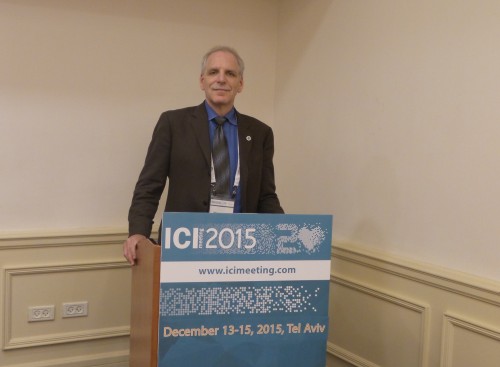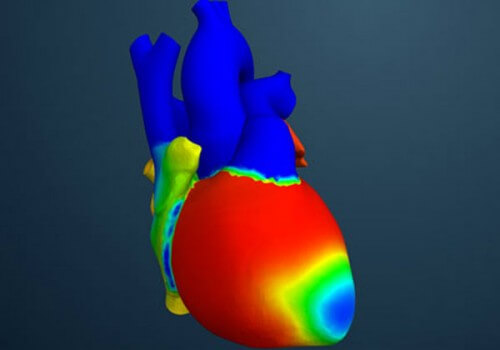Dr. Steven Levin, chief strategy officer at Dassault Systèmes, and responsible for the strategy and vision of its simulation system - SIMILIA, demonstrated at the Israel Cardiologists Association conference the Living Heart Project, which Dassault Systèmes leads with more than 40 academic bodies, Science and industry from the world

Dr. Steven Levin, chief strategy officer at Dassault Systèmes, and responsible for the strategy and vision of its simulation system - SIMILIA, demonstrated at the Israel Cardiologists Association conference the Living Heart Project, which Dassault Systèmes leads with more than 40 academic bodies, Science and industry from the world.
What is the "Human Heart" project?
"In the automotive industry today it is customary to carry out crash tests of cars inside the computer. If in the past you had to build expensive prototypes, and therefore also few, today the cars are put through thousands of computer simulations, and then the model containing all the changes is transferred straight from the computerized design to production. ” says Levin.
"When you have a computer model you can also see what happens inside the car, what happens to the driver, especially to his neck during the crash. Today it is the standard. So why isn't this also the standard in the medical device industry? Is it something to do with the way the industry operates or the way it adopts technology? To fix this, we decided to establish a simulation of the heart that would be at the same level as there is in other industries."
"Before preparing the simulation, we needed to understand the basic tissue of the heart. As engineers we made simulations of the mechanics of the tissue, both passive (strength of materials - and even composite materials from the aircraft industry) and active and turned it into something that looks like a heart. We connected the structure with the geometry of the heart and with the electrical component (the nerves) and we arrived at a beating heart. In order to develop a verified model and translate the simulation technology to improve patient care, not only engineering capabilities are sufficient, but also scientific and neuromedical capabilities."
"After we gained experience, the system learns a variety of applications. For example, it is possible to try medical devices (and first and foremost supports - stents). We test different shapes and sizes of stents under realistic conditions because we can reproduce the movement of the heart and understand all the forces acting on it. Since the stent will shape itself thanks to the degrees of freedom built into it, we conduct experiments to make sure that its edges will not damage the artery."
"We also work with pharmaceutical companies - on the chemical effects of drugs on the electrical behavior of the heart. Today, to treat heart rhythm problems, you have to intervene through surgery, it may be possible to develop a drug that will solve the problem without the need for surgical intervention."
The model allows us to start at the level of the whole organ and go down the scale to examine the behavior of the cells and even the molecular structure. The data we generate for medical devices undergoing simulation testing is necessary for the regulatory process. We made sure that the heart supports the platform that manages the information from the mock up to production - 3D EXPIRIENCE PLATFORM"
Try stents in a realistic simulation
How did the idea come about?
"There were two things that led to this. First, it becomes clear that the way technology is used in manufacturing is much better than the way it is used in medicine. We talked to customers and saw that medical device companies used our tool but only to design the device and not to try it in a realicity environment. As a result, there were many surgeries that failed."
"The second factor was my daughter who was born with a serious heart problem - reversal of the functions of both sides of the heart. The doctors cannot treat her because they do not understand how her heart works, but nevertheless they implanted a pacemaker, which broke down several times inside the body. As an engineer it seems strange that with all the knowledge we have about the cardiovascular system we can do no more than make observations. It's as if an airplane company would build a thousand airplanes, send them into the air and see which one flies and then manufacture it. I spent 25 years talking to cardiologists to solve the problem. Fortunately, my daughter is functioning reasonably well today."
"This experience provided me with an insight into the limitations of the field, in terms of the ability to try devices because it is impossible to try devices in the hearts of children, and there are no virtual children like those who use them, for example, to design cars. In the medical industry we do not have a virtual patient. The doctors use their best judgment, but we in the industry do not help them as much as we could."
"I talked to a lot of experts and saw that everyone knew a piece of the puzzle, I set up the project to see if we put all the pieces together if we could understand. It looks promising.”
"We can help the doctor understand what is happening. Doctors can try different options of implanting the device to see which one will behave the best. We can see the future because we can speed up the aging process on the computer to see what the results of the surgery will be in two years. The computer won't give the answer, but it will give them a diagnostic tool that they didn't have until now."

As mentioned, it is still a heart as it should have looked in the books, what is needed to create a simulation of a specific heart?
"We have the ability to do this, all we need is data, we can use data from CT or MRI scans and in addition to the mechanical properties that can be measured we can build your heart. It is not carried out as quickly as it should be and is still not a routine process. In a few years it will be possible."
What do you think about the Israeli industry?
"In Israel there is a burst of innovation that does not exist in most of the world, there are very few places that look ahead like Israel. Here is the combination of recognizing the importance of multidisciplinary teams of doctors and engineers. In the US, which is also innovative, we have a longer history and therefore it is more difficult to do new things, therefore in my opinion Israel is aggressive and has intellectual resources, engineering expertise and support from the government."
Are Israeli bodies partners in the project?
"We have a number of clients in Israel in the field of medical devices and as a result of this trip I expect to work closely with Tel Aviv University and medical device companies, I am convinced that they will participate. As customers who use the tool, we can allow them greater involvement in the development of the technology."
When will we get such a simulation of the other body organs?
"It's hard to say when. It depends on the sharing of knowledge by doctors and other specialists, people who work on the brain or other organs. If everyone shares information we can do it in a few years. If they don't share, we'll have to do it step by step. Each organ in the body has its own database and body of knowledge."
